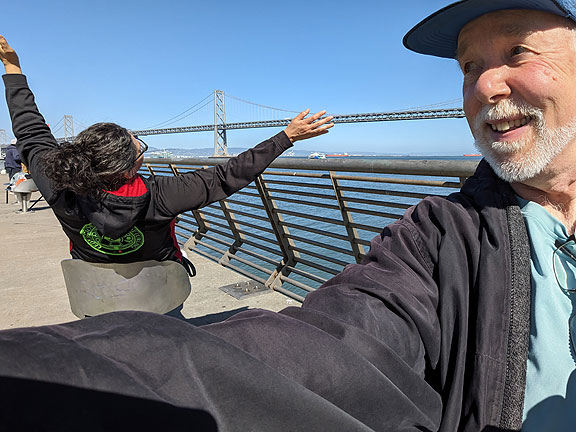
Googlers Against Genocide, several dozen of whom were fired recently after some inspiring protests mounted in and against their venal employer.
Malcolm Harris’s remarkable book, Palo Alto: A History of California, Capitalism and the World, is not only one of the best histories of California anyone has written, he’s also a fantastic writer. Right from the start he tells us he doesn’t want to write about himself because he’s “like a bad bowler, always headed straight for the gutters of historical context rather than for the pins of personal revelation.” Lest we doubt his ability to perceive the deeper truths about California, already on page 22 he declares: “If European leaders came to see the rest of the earth as their private juice box, then California’s engineers were on the ground aiming the straw.” And a dozen pages later he convincingly asserts “Anglo-American West Coast history is so brief that there is no California fortune we can’t trace back through these original expropriations of land and labor. It takes work not to see it.”
Harris delves into the post-Civil War era decisions that shaped the following century and a half of racist American history. Rather than concede to the liberatory impact of Reconstruction-era federal civil rights legislation, California politicians scratched the back of the defeated South, joining together to solve their linked need for cheap labor. They ceded the South to the Confederate redeemers and gained their support for the 1882 Chinese Exclusion Act. This allowed California’s agricultural capitalists (definitely not small family farmers!) to pedal “the state’s nonwhite labor like a bicycle: When they pushed one group down, another rose to replace it, and the whole contraption moved a little farther down the road. Via this continuous pumping motion they transformed the state’s cropland, from low-value wheat to high-value fruits, vegetables, and nuts. The commodities were expensive and the profits were high, but it’s the land itself where the real value accumulated.” (p. 123)
And this is where Harris really excels: explaining not only the deep history of California, but finding in this land-based accumulation of wealth the beating heart of what becomes today’s Silicon Valley. The directors of the California Real Estate Association met at Palo Alto’s fanciest hotel in March 1964 to plan a ballot proposition to preserve racially restrictive housing covenants, after a Fair Housing law had passed the state legislature and been signed by Governor Pat Brown. Proposition 14 won in every city in the state and passed statewide by a huge majority, only to be struck down a year later by the California Supreme Court as unconstitutional. But the ballot proposition had proven itself an indispensable tool for California’s radical right, “with capitalists mustering white voters into the civic vigilantism that had been part of western settlement since Leland Stanford was paying militias to hunt Indians.
Whiteness intertwined with home values in new ways in the last quarter of the twentieth century, but the California dream was always about land speculation premised on racial exclusion and domination. This relatively populist mode of wealth accumulation provided a safety valve for corporations as they competed to boost profits by reducing their commitments to society. Expanding suburbs bid down their business tax rates to lure industrial jobs, and the state’s tax burden—both in the rapidly growing ‘burbs and in the urban districts that capital abandoned with equal and opposite speed—shifted to individuals. (p. 379)

Encampment to protest Gaza attacks at UC Berkeley.
Harris goes on to argue that “California homeowners were on the vanguard of an international shift in value creation, from the wage-price inflation that characterized the previous period to asset appreciation. Wages were down; consumer prices were down; but houses? Houses were up.” With the passage of Proposition 13 in 1978 rolling back property taxes, the state’s budget was gutted and took a generation to recover. But Harris’s analysis is far more insightful than the usual handwringing from liberals about state budgets and tax financing. In Harris’s reading, Stanford University was not only home to enthusiastic eugenicists like school president David Starr Jordan, and the Termans and William Schockley with their tedious faith in IQ tests and racist hierarchies. It was also the fiefdom of the ultimate corporatist Herbert Hoover, who could never get over having lost his presidency to Franklin Roosevelt and the New Deal.
Organized capital’s Palo Alto faction bet big against communism and social democracy’s Popular Front, and though Hoover didn’t—realistically, couldn’t—live to see his final triumph over the New Deal, it’s his vision that won out—over the moderate wing of the GOP, the Democrats, the country as a whole, and history’s twentieth century. (p. 383) … Hoover had to watch his [housing] plan work from the sidelines, justifiably chagrined as FDR got credit for the suburban home boom. During the 1940s and ‘50s, Californians increased their homeownership percentage from the low 40s to the high 50s. Hoover lost the presidential battle, but his faithful servants in the real estate industry took off through history like an army of flying monkeys. As the shock troops of white reaction in California, they wrote and enforced segregation rules until the feds made them stop writing it all down, though that hardly ended enforcement. The “taxpayers’ revolt” that began with Prop 13 in 1978 and never really ended was part of the Hooverite solution to the threat of economic democracy. Leading the movement was seventy-six-year-old Howard Jarvis, a retired businessman and press officer for the 1932 Herbert Hoover presidential campaign. It took almost 50 years, but Hooverism was back on the march. The New Deal coalition fed itself a poison pill, basing the boom on a private housing system that, as we’ve seen, made a mint out of segregation. By financing the expansion of property, the state expanded the constituency for property rights as a counterclaim to the linked social democratic demands for racial equality and tax revenue to redistribute. (p. 393) … The state’s political class presented corporate divestment as inevitable, pitting stockholding homeowners against the beneficiaries of the compensatory state for whatever scraps were left on the table. This polarization reframed the domestic decolonization struggle: Innate white supremacy wasn’t a viable answer after Vietnam, but “individual rights” spun the progressive demand for personal freedom into a defense of the conservative status quo. To the demand of open housing, conservatives could answer with the right of property. Democratic control of resources in the collective interest was out; the sovereign individual was in. (p. 398) … The Reagan era—which includes Carter’s presidency as well as George Bush Sr. and, arguably, Clinton, George Bush Jr., Obama, Trump, and Biden, at the time of this writing—put America back on its narrative track. (p. 416)
As you can see in these short excerpts, Palo Alto is not focused on technology per se. Understanding the branding of Silicon Valley as a tech capital tends to obscure the deeper logic of racism, exclusion, land-grabbing, and wealth concentration that Harris sensibly puts at the center of his analysis. But he recognizes too that he needs to address the ideological promotion of technology as savior:
Competition and domination, exploitation and exclusion, minority rule and class hate: These aren’t problems capitalist technology will solve. That’s what it’s for. In the proper language, they are features, not bugs. This was [Stanford President] Jordan’s plan, [President Herbert] Hoover’s plan, [scientist William] Shockley’s plan, and now it’s [libertarian Trump-supporting founder of Palantir Peter] Thiel’s. (p. 606)

Parked next to the most radioactive place in San Francisco, Parcel E at the former Naval Shipyard at Hunters Point.
Palo Alto anchors dozens of recent books that seek to critically evaluate Silicon Valley and its globe-spanning influence. None of them take on the whole history of California or the world like Harris does, but Erin McElroy’s Silicon Valley Imperialism: Techno-Fantasies and Frictions in Postsocialist Times usefully extends the investigation into Romania’s efforts to nurture a tech boom, centered in the city of Cluj where Erin spent several years in the early 2010s. McElroy has been a key participant in San Francisco’s Anti-Eviction Mapping Project, and was a regular at dozens of protests against Google buses, AirBnB evictions, and ongoing rent battles and housing struggles in San Francisco since the early 2000s. Now they are a working academic in the northwest, though they continue to contribute to many campaigns in the Bay Area, Romania, and elsewhere. Silicon Valley Imperialism was just published by Duke University Press (and full disclosure, I’ll be on a City Lights panel with Erin on July 17 to discuss their book). Given McElroy’s personal involvement in squats and hackerspaces in Romania, they are able to focus the notion of an “imperialism” projecting from here to there with a great deal of practical insight. It is a bit of an academic book, so some parts are less accessible than others, but McElroy states unambiguously near the start of the book that Silicon Valley imperialism is “sowing the seeds of … its twin concept of racial technocapitalism. By this I refer to the technocapitalism imperatives undergirding racialized processes of data, land, infrastructure, and housing theft.” Recognizing the pitfall of universalizing concepts across farflung and radically different cultures and geographies, McElroy nevertheless wants to sow their own seeds “for anti-imperial future-making.”
McElroy importantly centers a post-Cold War paradigm in which liberalism and illiberalism occupy “an epistemological impasse at the center of the political-ideological spectrum, one that obfuscates how the material violence of capital and empire spectrally haunts both the so-called East and West today.” McElroy traces Silicon Valley back to the Enlightenment, and argues that contemporary liberalism “messily collapse[s] fascism, authoritarianism, communism, and unAmericanism” into a blockage in contemporary imaginations. Their time in Romania and other parts of Eastern Europe helps confirm that “socialism—as utopic and anticipatory project—has been discredited as a dream from the past, [but] in fact, it has never fully arrived… part of the problem [is] that much of the Western left today still only imagines the alternative to capitalism being state socialism.” Erin strikes a perhaps too hopeful note when they argue, “Common people today are after all actively opening futures for anti-imperial collectivities. This is not done in the cramped space of the sharing economy, but rather in affective worldmaking spaces of bus blockades, playground demonstrations, and anticolonial speculation.” I’d love that to be true, and while I support all those things, I think it’s a bit of a reach to claim that such activities constitute “worldmaking.”
McElroy’s penetrating query into “technoliberalism” in the context of its Romanian incarnation reinforces the sense that “sharing economy grammars have appropriated socialist understandings of communalism in order to advance capitalist expropriation (p. 72-73)… Liberal futurity and its technologies … require the predation of anticapitalist ideals.” (p. 88) The original pitch by Uber and Lyft that they were “sharing” apps, or AirBnB that it was an app to facilitate “sharing” your home have fallen away now, but definitely softened potential objections to their original (law-flouting) appearance. To a real extent these (vaguely socialistic) claims have inspired plenty of tech workers who have given months and years of their lives supposedly to make the world a better place.
One of McElroy’s great revelations is the Romanian concept of șmecherie, which is
antithetical to normative socialist and transition technonarratives, signal[ing] a form of deviancy and excess beyond capitalism’s scarcity logics… Future rebellions necessitate “discovering new ways of sharing technical instruments and developing institutions of pedagogy and experimentation that establish cultures of knowledge production…” Such collective technicity can be found within socialist and postsocialist experimentations of șmecherie… (p. 174)
Few Bay Area residents understand that Romania became a state socialist tech capital when it was part of COMECON, the Soviet Union’s economic bloc, building early computer clones and locally made PCs. Even further back, Romanian fascists embraced IBM punch cards during the Nazi era for population control, as did the German government, creating a legacy of state-sponsored technological development rooted in Romanian society. Pointing to the fear-mongering about postsocialist hackers, McElroy weaves together a fascinating discussion of Dracula and Romanian imaginaries to reveal how today’s “technofascism… glom[s] onto the figure of the illiberal Eastern European hacker rather than US technocapitalism,” thereby obscuring the role of low-paid Romanian call center workers, programmers, and designers in the new networks of global production, not to the mention the legions of people incinerated, shot, and worked to death in times past.

McElroy offers a rousing conclusion wherein she cites Wendy Liu’s book Abolish Silicon Valley: How to Liberate Technology from Capitalism (Repeater Books, London: 2020):
An abolitionist politic then needs to entail more than decommodification of things rendered as property, but also the abolition of worlds in which people can be owned, incarcerated, and exploited. It is one that stands up against racial technocapitalism freeing land, housing, bodies, and data from dispossessory logics. It would also seek to, as Wendy Liu argues, abolish Silicon Valley, which for her means remaking the world outside of capitalist logics, “decommodifying essential goods while also radically transforming the way we think about work.” Unbecoming Silicon Valley is thus a worldmaking project committed to remapping Siliconized lands and labor through abolitionist and anti-imperial visions. (p. 215-216)
Liu, who was one of the panelists at the Luddite Tribunal last year in Oakland, published her book in 2020. It peels back the veneer of enthusiastic complicity that seems to characterize so many tech workers’ attitudes to their jobs. She spends many chapters detailing her long descent into dissent, describing the grinding emptiness of her life in a startup (which she chose after refusing a Google internship when she saw it as a path to an inevitable and unbearable fulltime corporate life). She did not emerge from a critical cultural upbringing that encouraged her to reject the “success” that the world laid out before her, and for much of the book she is deeply conflicted about her growing awareness that her work is fundamentally pointless. Glimmers of near success for her startup fuel her 80-hour weeks and bad diet even while she begins to add up the glaringly obvious truth that their product is shit, serves no one, is based on scraping user data from social media sites, and—absent a much hoped-for buyout with a golden parachute for the founders—has no commercial future. She does a great job of giving us an insider’s view of how the incentives and rewards built in to the highly competitive startup world keep feeding its technicians and engineers enough of the puzzle-solving “joy” they need to keep them working. But she ultimately sees through it.
I wondered how much of the new tech boom was propped up by the naive dreams of aspiring startup founders like us, living off savings or credit card debt, working on problems they didn’t really believe in because they thought it was the only way to succeed—because they saw this as the path to fame and fortune, or at least a less mundane alternative to working a 9-6. When really, they were doing cheap R&D for other companies. (p. 58)… We all knew that this “smarter marketing” stuff signified exactly null, right? That was just what we said to get people to invest, surely? The truth was, I didn’t know else we were other than the exaggerated claims and rounded-up numbers of our uninspiring pitch-deck. (p. 82)
Eventually she defines her call for abolishing Silicon Valley as “freeing the development of technology from a system that will always relegate it to a subordinate role: that of entrenching existing power relations.” She says it means designing a new system outside the logic of the market, and finally liberating ourselves from the illegitimate reign of capital. She came a long way, baby, from where she started her book! I appreciated her sensible conclusion, including her recognition that a lot of her earlier obliviousness was simply because she didn’t think the problems she discovered in the logic of Silicon Valley affected her.
In a sense, abolishing Silicon Valley isn’t really possible—at least not anytime soon. And yet the point of making the demand is to illustrate that the systems that govern our world are constructed—the product of choices by human beings who came before us. Things weren’t always like this, and they don’t have to be like this either. (p. 207)

Inside an old theater once called Bonita Hall at 2787 Folsom Street on the late April 2024 day before the evicted tenants vacated the place. There’s an amazing history here!

Same room, different angle… once a Russian Anarchist reading room, the old stage has been blocked for decades, but also provided space for all sorts of staged plays and performances by the International Group in the 1920s and 1930s.
In some ways Kyle Chayka is trying to reach a similar conclusion in his Filterworld: How Algorithms Flattened Culture (Doubleday Books: 2024). He is a young writer for various New York publications and took on this effort in part to defend his own aspiration to be a cultural arbiter, a role he recognizes is being gobbled up by algorithmic recommendation engines. As a digital native, he’s coming of age and describes himself at one point as “entering my late twenties as a Brooklyn resident and looking for some definition of what adult life should look like—in essence, how and where to spend the little extra money I had.” A revealing statement for a cultural maven of our era, even one who is struggling to break free from being entirely engulfed by the banal homogenizing of his own personal taste: he sees adult life as being defined by discretionary spending! I actually think he’s a lot more intelligent than that, but it takes a long time in this book to get to the punch line that seemed like it could have been written in the first 20 pages at least.
That feeling—that truth and authenticity are evasive and we are discouraged from seeking them by a series of digital mediations, seems to be at the heart of Filterworld. (p. 127)… Even in the short time of their rise, algorithmic recommendations have warped everything from visual art to product design, songwriting, choreography, urbanism, food, and fashion. All kinds of cultural experiences have been reduced to the homogenous category of digital content and made to obey the law of engagement, the algorithms’ primary variable. Any piece of content, whether image, video, sound, or text, must compel an immediate, albeit often superficial, response from the viewer. It must make them tap the Like or Share button, or prevent them from hitting Stop or Skip, anything that would interrupt the feed. (p. 277) … Eventually Filterworld itself, with its set of entrenched styles, will prove to be a finite phase of culture, precisely because it will run out of fuel and run aground on its own self-referentiality. Something new is on the horizon; whether is a flood of even more artificial content generated by artificial intelligence machines or a renaissance for human self-expression depends on our choices. (p. 280)
So this is the world wrought by the dominance of Silicon Valley and the tech monopolies that are at its heart. Cory Doctorow is an anti-monopolist tech writer in addition to being one of our most prolific authors. I love his novels, starting with Down and Out in the Magic Kingdom, the Little Brother trilogy, and his recent The Last Chance. In his The Internet Con: How to Seize the Means of Computation (Verso Books: 2023) he offers some regulatory proposals that might lead to a diminishing of the power of the big tech companies on our lives. Certainly the Federal Trade Commission and Lina Kahn hope that their lawsuits against Google and Amazon and Apple will be the beginning of an epochal unwinding of the monopolizing power they’ve each seized. Doctorow goes beyond the surface complaints about monopolies from merely an efficient markets point of view:
Tech monopolies are epiphenomena: they are effects, not causes. They are the effect of an ideology that embraces monopolies and inequality as a natural, even inevitable phenomenon. It’s an ideology that lionizes monopolists as once-in-a-generation geniuses who deserve the power to structure the daily routines and constraints of billions of their fellow humans. That is the ideology that produces regulatory capture (because when an industry consists of a handful of companies, everyone qualified to regulate it is a veteran of one or more of its largest corporations). (p. 150)
While I’m certainly in favor of breaking up monopolies and seizing their wealth and power, I have no confidence in the Biden administration, even with worthy individuals staffing various agencies like the aforementioned Lina Kahn. The kind of social and political movement that might be able to do it would have to be rooted in a refusal to keep producing this world by the work we do. Governmental regulation for the good of the capitalist system at the expense of a few powerful monopolies is hardly a recipe for radically changing our course. Even amending section 230 of the Communications Decency Act to make social media companies responsible for their filters and ensuing editorial decisions, as some suggest, won’t do much for the kind of changes we need.
Outside of tinkering with monopoly regulation, it remains the case that Filterworld is based on advertising, which as Tim Hwang wrote about four years ago in his Subprime Attention Crisis, is a huge ponzi scheme and hardly a sustainable business model (I blogged about it here but you have to scroll pretty far down). This is to say nothing of the dominance of the military-industrial complex in the initiation and ongoing funding of most of the tech industry, something I addressed in this post. On various podcasts I listen to it seems that the AI boom may already be cresting, and it’s already looking a lot like another emperor with no clothes.
There are heartening reports appearing about schools banning smart phones, parents choosing to keep their kids off screens as long as possible, etc. Perhaps we are on the cusp of a return to the Analog, or at least a general exodus from the obsessive-compulsive use of social media and the internet (ever worse with every passing day). Maybe public gatherings, festivals, protests, and new forms of being together will emerge as humans simply grow disgusted at how much of our lives is being wasted clutching these infernal devices. Maybe we can learn again to argue and debate and philosophize together in public! Wouldn’t that be something!

Having a spin at Pier 14…

An Echo Azure butterfly on San Bruno Mountain recently.

View north from upper reaches of oak forest above Buckeye Canyon on San Bruno Mountain.












Leave a Reply